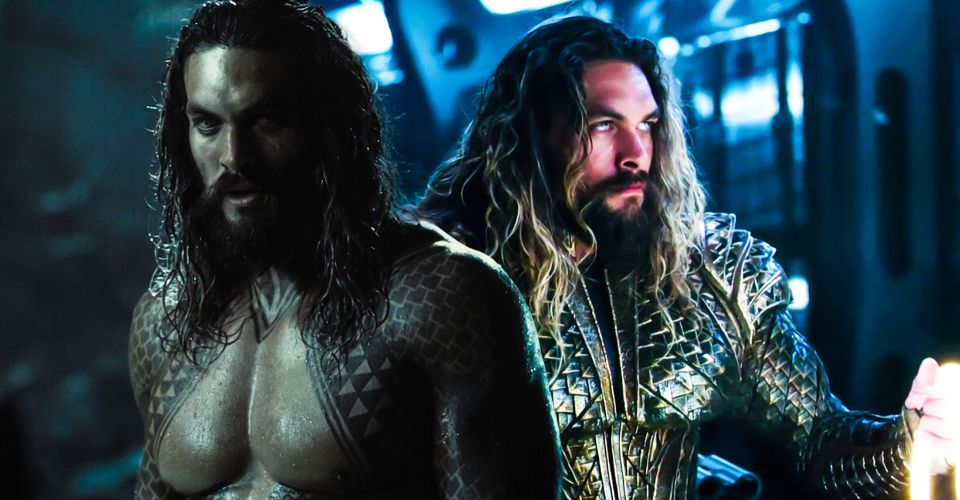How Aquaman Is Different In The Justice League Snyder Cut

All of the main heroes are drastically different in Zack Snyder’s Justice League, but how is Aquaman’s portrayal different from how he was seen in the Snyder’s reshoot-filled 2017 theatrical version? The Snyder Cut can now be viewed on home media after its streaming debut in March of 2021. Comparisons with the theatrical cut, which spliced in bits of Zack Snyder’s original footage with the massive reshoots conducted after his departure, continue to be a major and largely unavoidable element of the Justice League experience, namely on the basis of each individual character’s role in either version of the film.
Following Justice League‘s failure in theaters, Jason Momoa would go on to lead the Aquaman solo film, which debuted in December of 2018. He also became the first member of the cast to vocally support the Snyder Cut’s release, and on the Aquaman press tour no less, where he famously declared “Yeah, f–k yeah, I want to see it!” Fast-forward to the movie’s two-year anniversary, other cast members and many other celebrities joined in making the call that ultimately led to the Snyder Cut being given the greenlight.
Like the other heroes of the League, the portrayal of Aquaman seen in the theatrical cut stood totally at odds with how he was shown in the Snyder Cut. While there are countless subtle differences between the two versions overall, a number of larger elements stand out in the presentation of Aquaman made by the two cuts of the film. Here are the biggest ways in which Aquaman is different in the Snyder Cut compared to the theatrical version of Justice League.
Arthur’s Character Traits Are More Defined

Hampered by a two-hour mandate, the theatrical cut of Justice League didn’t imbue a lot of depth into its characters. When it came to Arthur, the movie didn’t go much further than positioning him as a cool tough guy. The Justice League scene of Arthur walking down a pier while drinking from a whiskey bottle particularly exemplified this, the editing and soundtrack differences in the two versions resulting in an Aquaman scene with a completely different feel in either version.
The Snyder Cut’s portrayal of Arthur is much more three-dimensional, showing him as gruff and somewhat anti-social due to his mixed human-Atlantean heritage. Arthur’s relationship with his fellow heroes is also more layered, with Arthur’s reluctance to trust other people slowly eroding as he eases into his relationship with the rest of the League. What also helps Arthur greatly in his character development is how much more the Snyder Cut goes into his origins and relationship with Atlantis compared to the theatrical version.
Arthur’s Backstory Is Featured More Prominently

The theatrical cut was also short on Aquaman’s backstory and connection to Atlantis. Arthur’s meeting with Bruce Wayne set up a rough relationship between Arthur and the undersea kingdom. His meeting with Mera after the now much more powerful Steppenwolf steals the second Mother Box also included Arthur’s comment about being left by his mother Atlanna and Mera admonishing him that he’s needed to stop Steppenwolf, along with Arthur’s line later in the film that he “never really embraced the sea or the land.” In the end, that was about as far the theatrical Justice League cut went into the origins of the future King of Atlantis.
The first two scenes above are still in the Snyder Cut, with the former only including Arthur’s final line about being wanting to left alone, while a much clearer picture is made of Arthur as an Atlantean in his meeting with Willem Dafoe’s Vulko. Vulko urges Arthur to step in as “snatchers” are kidnapping Atlantean soldiers and warns about Arthur’s half-brother King Orm attempting to leverage this into a war with the surface, along with presenting Arthur with his mother’s trident and Atlantean battle armor – as opposed to Mera giving him both off-screen in the theatrical cut. Despite this, Arthur continues to regard Atlantis as “a brutal, petty, superstitious race.” In addition to the Snyder Cut’s version of the pier scene, viewers get a much clearer portrayal of Arthur Curry as a human-Atlantean hybrid and heir to the kingdom’s throne, alongside his antipathy towards Atlantis and avoidance of assuming the throne. Arthur’s ties to Atlantis are also deepened in the Snyder Cut in another way.
Arthur & Diana Begin Things Anew For Atlantis & Themyscira

Wonder Woman’s significantly sexualized portrayal in the theatrical version of Justice League was among its most controversial elements, particularly the scene of Barry Allen faceplanting into her chest, with the Snyder Cut veering away from this depiction of Wonder Woman. Aquaman was also part of this scene where he pours his heart out to the League while unknowingly sitting on Diana’s lasso, which causes him to confess his infatuation with her. This scene also included a brief comment by Arthur, “I know we went to war with Amazons, but that was before my time”, and this was another area where the Snyder Cut gave more detail on the histories of both of their cultures.
While Barry and Victor dig up Superman’s body in the League’s plan to revive him, Diana notes the irony of an Amazon and an Atlantean working together as allies, with Arthur quick to point out he’s only half-Atlantean. Diana also describes hate as “useless” when Arthur asserts his hatred for Atlantis, and the two realize Atlantis and Wonder Woman’s homeland of Themyscira share a common saying: “None are taken back from the darkness, not without giving one up in return.” The scene shows an Atlantean and Amazon finding common ground for the first time in eons and Arthur, without even realizing or wanting to, now as much an Atlantean diplomat as he is a hero in the Snyder Cut.
Arthur’s Relationship With Victor & Barry

In both versions of Justice League, Aquaman has both a distrust of Cyborg and an annoyance with The Flash, with the two versions showing this in footage exclusive to either. In the theatrical cut, Arthur never really comes to hold a more positive view of either Victor or Barry in an organic way, distrusting Victor as a possible Apokoliptian sleeper agent and Barry as an all-around clumsy dork, a view surely not helped by Flash’s problematic running style in the Justice League‘s theatrical cut. This is another area where his portrayal in the Snyder Cut is significantly different.
Arthur is still suspicious of Victor, and calls out Barry tripping him up in the Heroes Park battle with Superman with an angry finger point. However, Arthur expresses empathy for Victor after the death of Silas Stone, saying it’s “not right” that Victor should be called upon to save the world after his father’s death. This and his calmer demeanor towards Barry show he’s come to appreciate how much the two youngest members of the League are being asked to take on, even as he tries to hide it. By the final battle with Steppenwolf, Aquaman’s developed much more camaraderie with not just Barry but especially Victor, asking him if he’s ready for “Round two?” against Steppenwolf. To this, Victor responds, “Hell yeah.“
With fans continuing to push for the SnyderVerse’s restoration, the examination of the all the major and minor differences between both theatrical and Snyder Cut versions of Justice League is sure to continue to be poured over intensely. Aquaman, once the most mocked superhero in the world, can now lay a claim to being one of DC’s MVP characters with his solo film being DC’s biggest hit ever and Aquaman and the Lost Kingdom on the way. At the same time, though it took an unusually long time, the world has finally gotten to see Arthur Curry as Snyder intended to depict him in Zack Snyder’s Justice League.
- The Batman (2022)Release date: Mar 04, 2022
- DC League of Super-Pets (2022)Release date: Jul 29, 2022
- Black Adam (2022)Release date: Oct 21, 2022
- The Flash (2023)Release date: Jun 23, 2023
- Aquaman and the Lost Kingdom (2023)Release date: Mar 17, 2023
- Shazam! Fury of the Gods (2022)Release date: Dec 16, 2022
About The Author


















